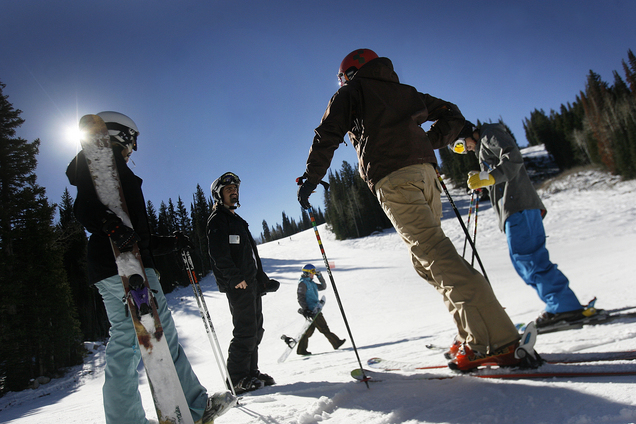
Skiers talk at the base of Solitude’s Little Dollie run. (Photo by Scott Sommerdorf/The Salt Lake Tribune)
By Tom Wharton
The Salt Lake Tribune
At the start of every ski season, tourist officials offer the public glowing reports about the value of the industry to the economy, new facilities and the general health of the industry.
The reality, as evidenced by research into national and Utah skiing trends, is much different.
According to a recent national report from the SnowSports Industries America (SIA), participation in alpine skiing dropped 19 percent last winter and overall snow sports participation was down 3 percent.
The report showed that lesson volumes have been flat, season pass and multi-day ticket sales are down, the popularity of snowboarding is on the decline and ticket prices are increasing.
Sixty-two percent of the 19.3 million snowsport enthusiast are male, 54 percent have incomes of more than $75,000 a year and 74 percent own their own home.
In Utah, 65 percent of skiers have incomes of more than $100,000 and 30 percent make more than $200,000. The average age of a Utah skier is 44.1 and 43 percent of skiers live in households with children compared to 21 percent who are singles with no kids.
Snowboarding is not particularly popular in Utah either. Only 17 percent of Utah snowsports participants snowboard. Nationally, the total bumps up to 29.6 participants visiting a resort, down from 32 percent three seasons ago.
Utah skews slightly more advanced and expert when it comes to its snow sports participants, with 56 percent rating themselves as more advanced or expert compared to 45 percent nationally. Fifty percent buy single-day tickets.
The vast majority of Utah skiers drive to resorts, with only 10 percent using public transportation.
While the Beehive State has experienced a decline in trial or first-time destination visitors, repeat visitation is growing, with about 79 percent who have skied here having visited the state one other time.
The SIA national report measured alpine ski numbers, snowboarders, cross country skiers, freeskiers, snowshoe enthusiasts and telemark skiers. During the 2012-2013 season, only freeskiing showed healthy growth, though the number of telemark skiers was up slightly.
Alpine skiing remains the most popular activity, with 8.2 million participants in the recent report. But that is a substantial drop for the 11.5 million during the 2010-2011 season.
Part of these drops can be attributed to a late-starting season in 2012-13, with many resorts not really operating fully until after the Christmas holidays.
Reacting to some of these figures, the ski industry is trying to do everything possible to bring young people into the sport.
At his most recent season-opening press conference, Ski Utah President Nathan Rafferty promoted programs such as a program where fifth graders can buy an online pass for $30 that gives them three days of skiing at all 14 resorts. Park City Mountain Resort is offering a StartNow program including five sessions of instruction for first-time ski and snowboard students that include lift access, equipment rentals and lessons for $40 per session. Snowbasin is offering a free season pass to skiers who participate in five beginner lessons.
Rafferty said Utah ski resorts, which generate 20,000 jobs and bring in $1.3 billion to the state’s economy each year, has set a goal of giving 10,000 beginner lessons in January, which is Learn to Ski and Snowboard Month. Several resorts will offer packages for less than $40 a day.
